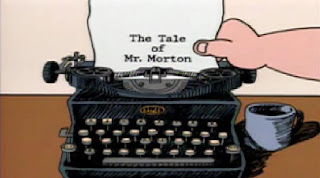‘Mr Morton is the subject of the sentence, and what the predicate says he does.’
So says the catchy Grammar Rock anthem. Never heard of it? Then try typing Mr Morton into Google and see what you get. Yes, he really is that famous!
Of course, you may be questioning the value of a 1993 U.S. elementary school cartoon voiced by a Frank Sinatra sound-alike – especially if you happen to teach secondary school English in a tough UK inner-city comprehensive to bored, pseudo-sophisticated teenagers who are far more street-smart than the hapless Mr Morton could ever hope to be. Well, it’s a starting point – an eye-catching and fun introduction into the murky world of sentence grammar.
But why bother with such a last-century approach, especially when the current curriculum is already jam-packed with hopelessly ambitious aims and objectives? Well, regardless of whatever GCSE English syllabus you are following, students need to be able to write grammatically correct sentences and use a range of sentence structures for effect, especially if they want to achieve the higher grades. So if they don’t have the basics of sentence grammar, how are you going to convey this to them?
You could always fall back on such standard first-draft comments as: ‘You need to vary your sentence openings more’. Or you could go all out for a first-rate fudge with the catch-all: ‘You must use a wider range of sentence structures!’ But this is all rather vague and meaningless to a student who has no idea what a sentence structure actually is. So how much should you tell them? In all honesty, as much as they need to know AND as little as possible – just as much as is required for you to engage in a meaningful dialogue after you have proof-read a rough copy.
At the very least, you might teach them that:
- A sentence begins with a capital letter and ends with a full stop, question mark or exclamation mark – but, of course, usually with a full stop!
- The most basic of all sentences is a simple sentence which contains one main clause.
- A clause is a unit of meaning within a sentence.
- A main (independent) clause is a complete unit of meaning.
- A subordinate (dependent) clause is not a complete unit of meaning and, therefore, cannot stand on its own as a sentence.
- As well as the simple sentence, there are also two other main sentence types: compound and complex.
- A compound sentence consists of two main clauses joined by a coordinating connective (FANBOYS: For, And, Nor, But, Or, Yet, So).
- A complex sentence consists of one main clause and one or more subordinate clauses.
- A very effective default sentence structure is a complex sentence consisting of two or three clauses.
- This can then be complemented by a judicious use of dramatic simpler sentences, or richer more sophisticated longer sentences.
- A very effective way to vary sentence openings is to alternate between a main clause, a dependent clause, a single word sentence opener and a short phrase sentence opener.
- And why not throw in the occasional rhetorical question for effect?
- It’s also probably well worth continually emphasising that they should strive to combine all of the above with a precise and powerful vocabulary.
Of course, there is no need to teach all of this in one go; it seems an appropriate theme for a year’s worth of starters!
So what will the end product look like when it’s all been assembled? That is the acid test. Hopefully, you will be thrilled with the result, especially if your students have also learned how to use commas to demarcate clauses where necessary. Assuming that all of the above has been successfully acquired, you should certainly have an extensive array of sentence openings. This newly acquired mastery of sentence grammar might well inspire your students to even dizzier heights and the ensuing sense of personal achievement could ultimately be compounded by dazzling GCSE grades. Finally, if you have also managed to introduce them to the seductive art of the embedded clause, their future output may even look a lot like this!
QUICK QUIZ BASED ON THE SIX SENTENCES IN THE ABOVE PARAGRAPH:
1.Which two sentences begin with a single word sentence opener followed by a comma?
2.Which sentence is a rhetorical question?
3.Which sentence consists of only a main clause?
4.Which sentence contains an embedded clause?
5.Which sentence is a compound sentence?
6.Which sentence begins with a dependent clause?
ANSWERS:
1.Three and six
2.One
3.Two
4.Six
5.Five
6.Four
COMPLEMENTARY RESOURCES
1.http://www.youtube.com/watch?v=sk-XA5pKkGE The Tale of Mr Morton – original version
2.http://www.youtube.com/watch?v=Dj4H3Ioxs6s The Tale of Mr Morton – rap version by Skee-Lo
Peter Morrisson
English Teacher and author



